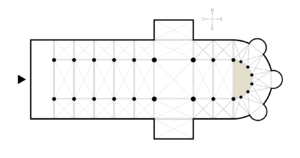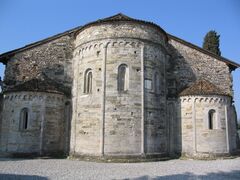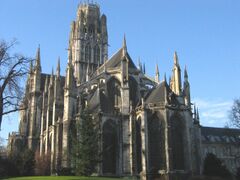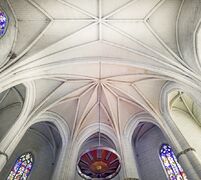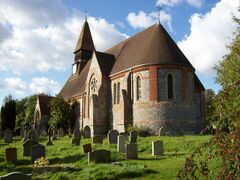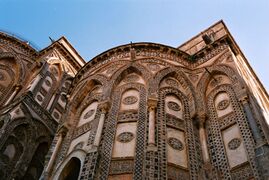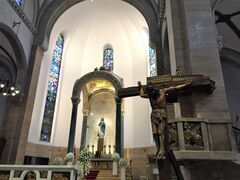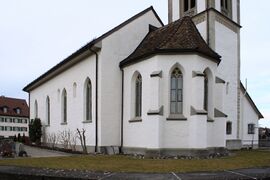حنية الكنيسة
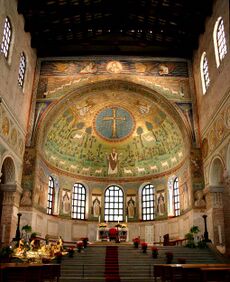
In architecture, an apse (plural apses; from Latin absis 'arch, vault' from Ancient Greek ἀψίς apsis 'arch'; sometimes written apsis, plural apsides) is a semicircular recess covered with a hemispherical vault or semi-dome, also known as an exedra. In Byzantine, Romanesque, and Gothic Christian church (including cathedral and abbey) architecture, the term is applied to a semi-circular or polygonal termination of the main building at the liturgical east end (where the altar is), regardless of the shape of the roof, which may be flat, sloping, domed, or hemispherical. Smaller apses are found elsewhere, especially in shrines.[1]
تعريف
An apse is a semicircular recess, often covered with a hemispherical vault. Commonly, the apse of a church, cathedral or basilica is the semicircular or polygonal termination to the choir or sanctuary, or sometimes at the end of an aisle.
Smaller apses are sometimes built in other parts of the church, especially for reliquaries or shrines of saints.[بحاجة لمصدر]
التاريخ
The domed apse became a standard part of the church plan in the early Christian era.[2]
سمات ذات صلة
In the Eastern Orthodox Church tradition, the south apse is known as the diaconicon and the north apse as the prothesis. Various ecclesiastical features of which the apse may form part are drawn together here.
Chancel
The chancel (or sanctuary), directly to the east beyond the choir, contains the high altar, where there is one (compare communion table). This area is reserved for the clergy, and was therefore formerly called the "presbytery", from Greek presbuteros, "elder",[بحاجة لمصدر] or in older and Catholic usage "priest".[3]
Chevet-apse chapels
Semi-circular choirs, first developed in the East, which came into use in France in 470.[4] By the onset of the 13th century, they had been augmented with radiating apse chapels outside the choir aisle, the entire structure of apse, choir and radiating chapels coming to be known as the chevet (French, "headpiece").[5]
معرض
Triple apse of Basilica di Santa Giulia, northern Italy
East end of the abbey church of Saint-Ouen, showing the chevet, Rouen, Seine-Maritime, France
Apsed chancel of St Mary's Church, West Dean, Wiltshire, England
The apse of Manila Cathedral, Philippines
انظر أيضاً
- Ambulatory
- Architectural development of the eastern end of cathedrals in England and France
- Byzantine architecture
- Cathedral architecture
- Church architecture
- Narthex
- Niche
- Scarsella
المراجع
- ^ "Basilica of the National Shrine of the Immaculate Conception: Floor Plan". NationalShrine.com. Retrieved 27 August 2016.
- ^ "Apse". Encyclopædia Britannica. Retrieved 10 July 2012.
- ^ "Where in the New Testament are Priests Mentioned". Catholic Answers. Catholic Answers. Retrieved 2018-09-01.
- ^ Moss, Henry, The Birth of the Middle Ages 395-814, Clarendon Press, 1935
- ^ "Chevet", Encyclopædia Britannica
- Joseph Nechvatal, "Immersive Excess in the Apse of Lascaux", Technonoetic Arts 3, no. 3, 2005.
وصلات خارجية
 Spiers, Richard Phené (1911). . In Chisholm, Hugh (ed.). دائرة المعارف البريطانية. Vol. 2 (eleventh ed.). Cambridge University Press. pp. 231–232.
Spiers, Richard Phené (1911). . In Chisholm, Hugh (ed.). دائرة المعارف البريطانية. Vol. 2 (eleventh ed.). Cambridge University Press. pp. 231–232. {{cite encyclopedia}}: Cite has empty unknown parameter:|coauthors=(help) This has a detailed description of examples in the early church.
- Short description matches Wikidata
- Articles containing لاتينية-language text
- Articles containing Ancient Greek (to 1453)-language text
- Articles with unsourced statements from May 2020
- Articles with hatnote templates targeting a nonexistent page
- Articles with unsourced statements from June 2014
- Missing redirects
- مقالات المعرفة المحتوية على معلومات من دائرة المعارف البريطانية طبعة 1911
- Arches and vaults
- عمارة الكنائس
